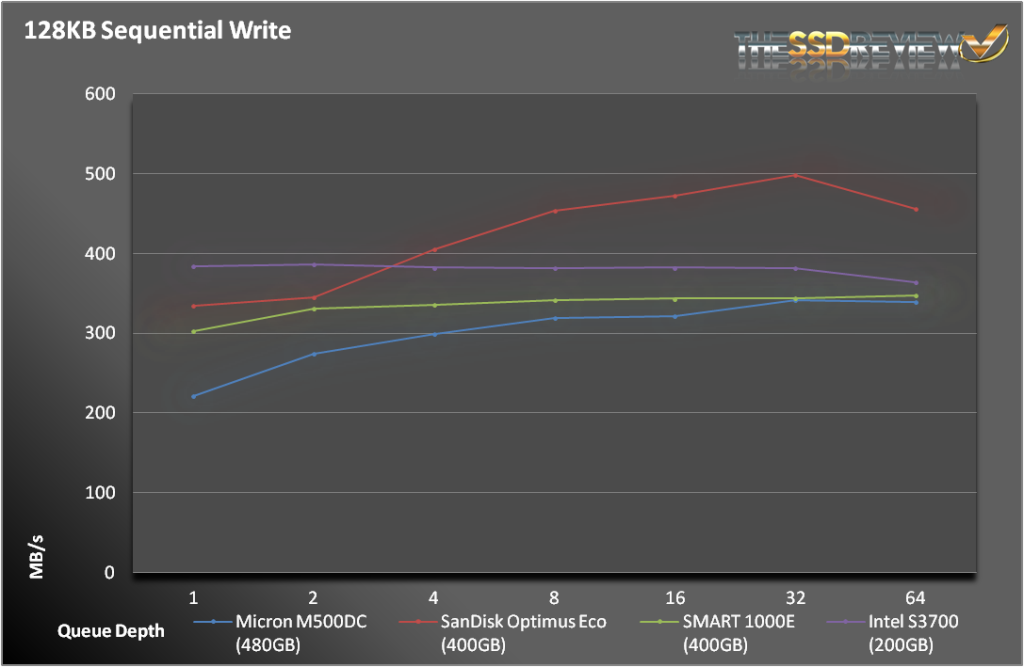MEASURING PERFORMANCE
As with all of our tests, the following tests were performed after a secure erase of the drive. The drive was also conditioned with a predefined workload until it reached steady state. We also test across the entire span of the drive.
Sequential operations are not exactly a strong point for the M500DC. It trails the majority of enterprise SSDs in both read and write operations. We expected the read performance to be low based on the specifications, but were a little disappointed that the writes were so low. For an SSD that is geared more towards writes, we had hoped for a little more performance.
Now that is more like it. Random write performance is stellar. The M500DC separated itself from the competition at all queue depths. Read performance was actually better than we had hoped. While only rated at 63K read IOPS, the M500DC consistently topped 70K IOPS, which put it within a few percentage points of the competition.
Now is a good point to remember that the M500DC is, more than likely, priced much lower than the other SSDs in this comparison. This makes the write performance even more impressive and the read performance more forgivable.
SNIA IOPS TESTING
The Storage Networking Industry Association has an entire industry accepted performance test specification for solid state storage devices. Some of the tests are complicated to perform, but they allow us to look at some important performance metrics in a standard, objective way.
SNIA’s Performance Test Specification (PTS) includes IOPS testing, but it is much more comprehensive than just running 4KB writes with IOMeter. SNIA testing is more like a marathon than a sprint. In total, there are 25 rounds of tests, each lasting 56 minutes. Each round consists of 8 different block sizes (512 bytes through 1MB) and 7 different access patterns (100% reads to 100% writes). After 25 rounds are finished (just a bit longer than 23 hours), we record the average performance of 4 rounds after we enter steady state.
- Preconditioning: 3x capacity fill with 128K sequential writes
- Each round is composed of .5K, 4K, 8K, 16K, 32K, 64K, 128K, and 1MB accesses
- Each access size is run at 100%, 95%, 65%, 50%, 35%, 5%, and 0% Read/Write Mixes, each for one minute.
- The test is composed of 25 rounds (one round takes 56 minutes, 25 rounds = 1,400 minutes)
With the SNIA tests, you can see how well an SSD transitions between different workloads. The M500DC gets out of steady-state very easily. You can see this behavior at the 4KB, 0% read level, where IOPS were over 42K. This is over 10% higher than our long-term steady-state tests.
We also observed that it didn’t matter if it was the first round of tests, or the last, the performance was very similar. Normally, we see decreased performance as the drive approaches a steady state, but the M500DC gave very consistent results throughout.
We were also slightly concerned with the saddle-effect that we observed. This is where the 0% read and 100% IOPS are much higher than the mixed workloads in the middle. IOPS drop fairly significantly in the middle. But, the story isn’t all bad. Even at a 50/50 mix, the M500DC still managed 28K IOPS, which is a really high number.
 The SSD Review The Worlds Dedicated SSD Education and Review Resource |
The SSD Review The Worlds Dedicated SSD Education and Review Resource | 


I can’t find any warranty information on this product except from this review. Does it really have a 5 year warranty? And where would you go to get a failing drive replaced under this warranty? Crucial doesn’t list it at all for warranty coverage.
Yes and that would be dealt with through Micron directly as it is as enterprise SSD. Simply contact them.
I have about 60 of these drives in two SANs. Phenomenal performance, I really love them. However I had one fail last week and the warranty process is a nightmare. They do NOT handle RMAs and warranties, they want you to go through the original reseller for the limited warranty. Newegg, Ingram Micro, CDW, etc. are NOT considered “authorized distributors” which means that Micron will NOT accept RMAs if purchased from them. If I had known this prior to purchasing I would not have gotten the Micron. Here is their list of “authorized” distributors. I am really unhappy right now. https://www.micron.com/support/how-to-buy/authorized-distributors
I am checking on this.
Let me know if you want me to forward you the email chain.
Any luck with Micron?
No response sorry.
Would the performance numbers and consistency of the 240GB be close to those of the tested 480GB drive?
edit:
I found this, what is a detailed meassurement of the 240GB Drives, and looks good.
https://www.thomas-krenn.com/de/tkmag/wp-content/uploads/2014/03/Micron-M500DC-240GB.pdf